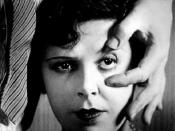Film: Un Chien Andalou
Director: Luis Buñuel
Country: France / Spain
Released: June 1929
Runtime: 21 minutes
Genre: Surrealism
Studio: Les Grands Films Classiques
Influenced: Hitchcock, David Lynch, Roman Polanski, Jodorowsky
Un Chein Andalou was written and directed by Luis Buñuel in collaboration with infamous surrealist artist Salvador Dalí in 1928. Neither the title ("an Andalusian dog") nor anything else in the film is supposed to make sense. It's placement of natural unrelated objects presented in an unnatural relationship, just like in dreams, is designed to purposely shock and provoke emotions from its viewers. Watching the film is a like riding a rollercoaster – sometimes you feel like you're hallucinating, sometimes you recoil in disgust, while some moments are weirdly erotic and others full of poetic force.
"For the first time in the history of the cinema, a director tries not to please but rather to alienate nearly all potential spectators" – film critic Ado Kyrou
The film scandalised bourgeois audiences at the time (a stated purpose of surrealist art) but viewers today may find its techniques less shocking, except for perhaps the famous scene in which the woman's eyeball is sliced open, or the shot of the man dragging the piano that has the priests and the dead donkeys on top of it. There is also a cross-dressing young man on a bicycle – Pierre Batcheff, an early star of the silent era who developed a drug problem during filming and, according to Dalí, wandered around, “continually smelling of ether”. For such moments, it remains one of the most famous short films ever made.
The idea for Un Chien Andalou came from a conversation Buñuel had with Dalí in which he recalled a dream that he had, in which a cloud sliced the moon in half, "like a razor blade slicing through an eye". Dalí countered with his own dream about a hand crawling with ants. "And what if we started right there and made a film?" asked Buñuel. So they did. In collaborating on the film Buñuel and Dalí's method was to toss shocking images or events at one another. Both had to agree before a shot was included in the film.
Shot over two weeks on a shoestring budget supplied by Buñuel's mother and without studio financing, Un Chien Andalou illustrates Buñuel's remarkable ability as a filmmaker and served as a calling card for Buñuel and Dalí into the elite club of the surrealists, led by Frenchman André Breton and his manifesto published in 1924. The film's success would allow the two artists to collaborate on their next groundbreaking work of cinema, L'Age d'Or.

Comments